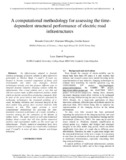JavaScript is disabled for your browser. Some features of this site may not work without it.
| dc.contributor.author | Ceravolo, Rosario | |
| dc.contributor.author | Miraglia, Gaetano | |
| dc.contributor.author | Surace, Cecilia | |
| dc.contributor.author | Zanotti Fragonara, Luca | |
| dc.date.accessioned | 2016-06-22T13:44:09Z | |
| dc.date.available | 2016-06-22T13:44:09Z | |
| dc.date.issued | 2016-04-05 | |
| dc.identifier.citation | Rosario Ceravolo, Gaetano Miraglia, Cecilia Surace and Luca Zanotti Fragonara. A computational methodology for assessing the time-dependent structural performance of electric road infrastructures. Computer-Aided Civil and Infrastructure Engineering, Volume 31, Issue 9, September 2016, pp701–716 | en_UK |
| dc.identifier.issn | 1093-9687 | |
| dc.identifier.uri | http://dx.doi.org/10.1111/mice.12199 | |
| dc.identifier.uri | https://dspace.lib.cranfield.ac.uk/handle/1826/9995 | |
| dc.description.abstract | An infrastructure adapted to dynamic wireless recharging of electric vehicles is often referred to generically as Electric Road (“e-road”). E-roads are deemed to become essential components of future grid environments and smart city strategies. Several technologies already exist that propose different ways to integrate dynamic inductive charging systems within the infrastructure. One e-road solution uses a very thin rail with box-section made of fibre-reinforced polymer, inside which an electric current flows producing a magnetic field. In spite of the great interest and research generated by recharging technologies, the structural problems of e-roads, including vibrations and structural integrity in the short and/or long period, have received relatively little attention to date. This article presents a novel computational methodology for assessing the time-dependent structural performance of e-roads, including a recursive strategy for the estimation of the lifetime of surface layers. The article also reports some numerical findings about e-roads that will drive further numerical analyses and experimental studies on this novel type of infrastructure. Finally, numerical simulations have been conducted to compare an e-road with a traditional road (“t-road”), in terms of static, dynamic and fatigue behavior. | en_UK |
| dc.language.iso | en | en_UK |
| dc.publisher | Wiley | en_UK |
| dc.rights | Attribution-NonCommercial 4.0 | |
| dc.rights.uri | http://creativecommons.org/licenses/by-nc/4.0/ | |
| dc.title | A computational methodology for assessing the time-dependent structural performance of electric road infrastructures | en_UK |
| dc.type | Article | en_UK |
Files in this item
This item appears in the following Collection(s)
-
Staff publications (SATM) [4368]

